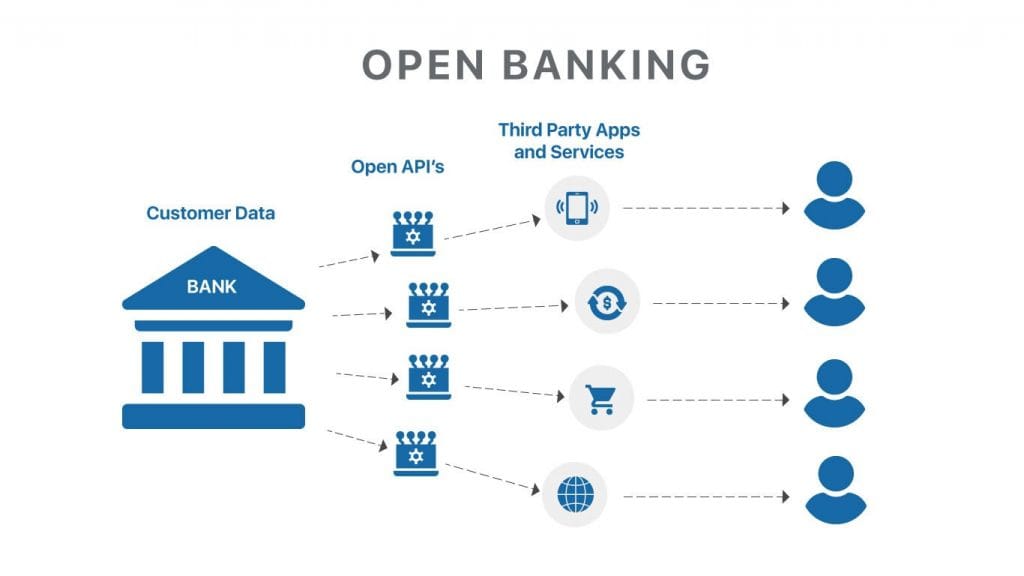 By Deepu George March 2, 2021
12 min read
By Deepu George March 2, 2021
12 min readOpen Banking API- Everything you need to know
Open Banking is a revolutionary technology in the digital world that forces banks to reinvent their traditional business models. Banks leverage open banking to collaborate and partner with fintech and third-party providers to stay ahead of this competitive curve. This rapidly evolving ecosystem is highly driven by Open Banking API as it changes the way incumbents interact with third-party providers. Open Banking not only transforms this but also revamps the way a consumer interacts with them.
Let’s explore more about open banking API and how leveraging open banking API will create an impact on banks and its customers.
What is Open Banking and how it works?
Open Banking enables sharing of customer’s financial information securely with the customer’s approval.
API permits third-party providers like Fintech to access the customer’s financial information that, in turn, helps to craft fintech apps and services for enhanced digital experiences. The fintech products that are built are not only for customers but also, for SMEs and startups to boost growth and revenue.

As open banking enables sharing of information to a regulated third-party provider, for your consent for sharing the information, you need to use your online banking credentials to log into your account and approve the third-party to access the information. The login credentials are always handled by the customer’s bank and not the TPP. Moreover, when the customer approves to access his information, TPPs have only “read-only” access, and therefore, TPPs can’t carry out a transaction.
Benefits your financial institution will leverage from Open Banking API
Open banking helps banks to enable higher customer engagement. Moreover, open banking API offers new insights that helps businesses and customers to make decisions about their financial assets. Let’s checkout the top benefits of Open Banking API.
- Customer Engagement: Enables customers to engage with their financial data in a secure, agile, and future-proof method with the changing financial ecosystem and customer demands.
- Payments: Boosts digital revenue by allowing customers to pay through digital and mobile wallets via their smartphones for almost every purpose
- Banking-as-a-Service(BaaS): Promotes an effective Open Banking API strategy through API-led connectivity by ensuring speed, agility, and innovation
- Remittance & Currency Exchange: Supports international money transfers and remittances through a simple, faster, and less expensive process with Open Banking API
- Customized Product Offerings: Benefits customers immensely by allowing financial firms to offer personalized products and services with greater transparency
Things to remember while implementing Open Banking
While implementing your own open banking, banks, fintech, and other regulators should keep in mind these initiatives:
- Time frame:
You can’t have an aggressive schedule to implement transformational modifications to complex financial systems. A financial system includes a lot of stakeholders. Therefore, you should have a flexible and properly planned time frame that will help in coordinating and implementing all the tasks and elements in a hassle-free manner.
- Smooth interaction and cooperation of open platforms
The financial ecosystem has already owned a plethora of APIs and world-class solutions that have delivered amazing customer experiences. To gain a frictionless adoption of open architectures, you need to accept open technologies to better flourish.
- Flexibility
Today, the pandemic has resulted in the revamping of financial models. Financial solutions that offer limited offerings are outdated. Consumers need personalized services. To plug in these new services in your fintech apps, you need to choose the best technological framework that can quickly adapt to the changes and also abide by the regulations.
- Preach the public
If you’re planning to make a significant change in banking services, your consumers have the right to know about those modifications and require knowledge to become aware of those services. Offer consumers the time to get acquainted with these changes and leverage the benefits of the same for higher engagement.
Top use cases of Open Banking
Open banking has gained huge popularity and has amplified due to the global pandemic and the surge in demand for online services.
A prediction by PwC states that by 2022, 71% of SMBs in the UK will adopt open banking, and two-third of adults in the UK will opt for open banking, resulting in a £7.2 billion revenue
To embrace open banking, you should know where exactly you require to integrate these APIs and drive value for consumers. Explore the top open banking use cases as below.
- KYC process automation: Open banking offers a streamlined process to fetch and verify customer information necessary for the customer due to diligence procedures.
- Customer onboarding: Open banking offers a simplified customer onboarding process by fetching hard-to-access financial information seamlessly. The customer onboarding process involves account and identity verification, auto-filling forms, income verification, and affordability checks.
- Financial management: Open banking API offers an optimal digital customer experience by allowing aggregation of financial information from different accounts and banks for easy money management. Moreover, open banking API allows easy finance management by offering finance dashboards, auto-saving, and smart budgeting. Also, open banking APIs play a major role in managing SME finances by offering seamless account aggregation, automated accounting, and affordability checks.
- Transaction monitoring: Open banking offers enhanced methodologies to improve customer profiles and make it easier for abnormal activity identification or any kind of anomalies in the data.
- Insurance: Open banking API offers unparalleled visibility of customers’ spending behaviors that results in better decisions for lending and insurance.
- Payments: Open banking allows a direct account to account payments, eliminating costs incurred by card processors. It further allows the customer to carry out the transaction from a single place.
- Product comparisons: Open banking platforms and advanced data analytics offers product recommendation service to the customer based on their spending behavior.
Top open banking rends in 2021
The modern and fast-growing consumer demands for financial services have led to vigorous competition between banks and fintech. Open banking offers incumbents an opportunity to handle this pressure by partnering with fintech. Open banking APIs are responsible for building and transforming relationships between financial institutions and their consumers by offering ownership to the consumers of their financial data.
As open banking has become a crucial theme for digital growth in the BFSI sector, it has paved the way for many trends that can be observed in 2021.
- The rising adoption of Open Banking APIs by SMEs and Millennials:
Open banking will enable banks to offer services to SMEs with the help of third-party financial providers. Open banking will allow easy management, cross-border payments, seamless multi-currency transactions, and checking accounts in a short period of time.
- The transformation of fintech:
Today fintech has touched payments, lending, wealth management, and insurance services to offer a world-class digital experience to customers. With the help of open banking, fintech can seamlessly integrate banking services with banks. This provides fintech a good platform for business expansion.
- A big take on Accounting Firms:
One of the popular trends of open banking APIs, SaaS-based accounting organizations leverage the power of open banking API to manage banking and accounting from the same platform.
- The emergence of Open Banking Platform:
Open banking platform plays a major role in offering seamless integrations on the plug-and-play model for banks and fintech to offer world-class banking services to customers.
- Tech giants to roll on Open Banking:
Tech giants are all set to partner with banks and platforms to launch full-fledged financial services for the customers with the help of open banking API.
- The requirement for API Standards and Operability:
This year there will be a lot of push on API standards and operability with the increase in adoption of fintech services and the emergence of Neo and challenger banks across borders.
Top open banking examples
Some of the top examples of open banking are given below.
1. Barclays: Barclays is a popular name in the open banking market. As it claims, it is the first UK bank that has enabled account aggregation inside its mobile banking app. Barclays’s open banking feature offers customers smooth account operability where the customers are allowed to view their accounts using their Barclays mobile app.
2. BBVA: BBVA had launched its BaaS, open platform in 2018 in the US. This open platform leverages the potentials of APIs that allow third parties to serve customers with their financial offerings without the need to offer a full suite of banking services.
3. HSBC: In response to the UK’s open banking regulations, HSBC had launched its Connected Money app in 2018. The Connected Money app provided customers a way to control their financial data and allowed them to view bank accounts, mortgages, credit cards, and loans with other banks, all in a single place.
Open banking challenges that regulators need to combat with
Open banking is rapidly impacting banks globally. This global phenomenon enables banks to increase customer engagement by offering new services and products. Though regulations are driving these changes, there are some market-led modifications that are posing a challenge to the regulators to keep pace with. Let’s explore these challenges.
- Instability of APIs:
One of the biggest challenges that third-party providers face is the unreliability of payments. Open banking faces issues with its technical infrastructure most of the time. The instability of APIs further creates friction that results in a negative payment experience.
- Unresponsiveness of APIs:
As per research by Open Banking Implementation Entity, UK had more than 5.7 million failed API calls in November. PSD2 enforces testing on their APIs during a surge in calls so that they can easily handle thousands of calls per minute. But, somewhere this process is overlooked and a high volume of calls causes high-reliability issues. Usually, the bank returns an error message when an API goes down. But, most of the time, banks shoot unclear messages such as different types of error code and vague messages.
- Lack of standards
To accelerate progress towards a truly open environment, there should be a universally adopted reference model or taxonomy. Right now every bank is crafting its own API with the help of a leading fintech development company that holds expertise in API development and deployment. But, this limits the openness and defeats standardization that holds PSD2 and Open banking together. This creates an issue for the banks to visualize multiple flows.
So what is next for banks?
With these huge challenges of open banking for banks, open banking platforms should smoothly enable intermediaries for accessing data securely and develop intuitive applications for customers.
| Crucial considerations | The next step banks have to take |
| Revamping legacy systems | Revamping banks’ legacy systems will offer: Active engagement with the API environment Agile and responsive intermediary layer atop the core banking and other backend systems. |
| Reinventing banking ecosystem | Banks need to reinvent their ecosystem to: Securely interact with 3rd party providers Deliver new and enhanced offerings Swift access of customer transactions and info |
| Data management | Banks hold heaps of customer data. They need to dig deep for innovative processes to manage their customers data and take full advantage of fintechs. |
| Comprehensive business models | Banks need to leverage the power of disruptive technologies with the help of fintech to tap on the new revenue opportunities |
In a nutshell, banks have to deal with their legacy system with the help of fintech. They can resolve this issue by providing a lightweight, robust, responsive, and agile ecosystem as a new emerging core.
This ecosystem will definitely bridge the gap between banks and Open Banking APIs by providing a platform for high-speed Open banking requirements. This ecosystem will have next gen capabilities for storage and messaging such as API, microservices, cloud, etc.
Wrapping it up!
Open banking allows third-parties to access financial information that is required for app development and services. Moreover, Open Banking API offers account holders greater financial transparency that offers optimal customer experience. This helps in acquiring new customers globally. Open Banking has a promising future by creating a greater impact on end-to-end digital experience for all the stakeholders in this process.
Author Bio


 Facebook
Facebook Whatsapp
Whatsapp LinkedIn
LinkedIn Pinterest
Pinterest














 Start Chat
Start Chat